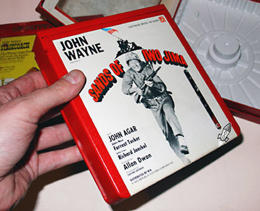How Cartrivision’s 1972 VCR Foresaw–And Forfeited–The Time-Shifted Future
prior to VHS vs. Betamax, a Silicon Valley startup introduced the VCR and home-film rentals and purchases to americans. And it failed large time.
September 21, 2015
“I give you and your loved ones instant access to tv applications, your collection of characteristic-size films, tutorial and cultural supplies, and your home films. you’ll discover and hear them in the privateness of your front room any time you want, with out riding anywhere, with out preventing crowds, with out advertisements or other interruptions. i will do this as a result of I’m a time machine, an extraordinarily unique kind of time computer.”
Who’s speaking? The iPad in 2010? YouTube in 2005? TiVo in 1999? To resolve the identification of this anthropomorphized narrator, you’ll have to return a bit additional. To 1972.
Three years sooner than Sony’s Betamax, greater than a decade prior to Blockbuster, and 25 years ahead of Netflix provided rented films by mail, a staff primarily based in San Jose, California, ushered american citizens into the era of time-shifting and on-demand video with the first consumer videotape recorder on hand in the U.S. Cartridge television’s Cartrivision may record and play back color-tv applications, play prerecorded videos, act as a closed-circuit security digital camera, and even play again dwelling movies recorded on its companion video digicam. It used to be an ambitious, versatile desktop. inside 13 months, it flopped.

Cartivision’s cartridges—8-inch plastic squares—had been inserted into a bottom-hinged compartment that closed into a colour-television console with the thunk of a car door. like the extra professionally oriented Sony U-Matic system that preceded it, Cartrivision might quick-ahead and rewind tapes. It also had a easy wind-down timer for scheduling recordings. whereas it didn’t provide the power to decide on a specific time and date like later VCRs, it used to be simple to use.
along with offering reusable blank tapes beginning at $15 for a 15-minute cartridge, Cartrivision was additionally early to recognize the value of video content material and offered a catalog of tape cartridges to buy or hire. just as with later VCRs, the choice ranged from wholesome domestic leisure (Roger Ramjet cartoons) to X-rated fare (non-public accountability Nurses). (“this will likely put pornography back within the house where it belongs,” stated an unnamed worker of Hornhill and Weeks-Hemphill, a Cartrivision investor, in a 1973 Washington post article.)
most of the 100 to 200 titles available to buy—costs ranged from $thirteen to $40—were tutorial or cultural applications, whereas the Hollywood releases were in most cases on hand just for rental, at $3 to $6 a pop. The latter integrated such classics as The Bridge on the River Kwai, wager Who’s Coming to Dinner, Dr. Strangelove, and excessive midday. That the corporate was in a position to offer Hollywood releases in any respect was once specifically impressive, given the movie business’s antipathy against dwelling video within the Nineteen Seventies, a sentiment that led to the well-known “Betamax case” of Sony Corp. of the usa v. common metropolis Studios, Inc.

simply as lately’s iTunes store enforces deadlines on digital movie rental by means of digital-rights management technology, Cartrivision employed analog-rights administration: rented tapes, supplied in crimson casings, will be rewound best with tools on hand at shops. That ensured that a client may handiest watch a movie as soon as.
integrated with coloration tv, Cartrivision may file and play again colour programming. then again, it offered a monochrome “immediate replay” video digital camera and additional optional microphone that could be used to make house films. although the digital camera, tapes, and home-tv player all got here from one firm, the video cartridges couldn’t be moved from the digicam to the television console, a la the VHS-C tapes that might come come a decade later. as a substitute, taking part in again the recordings required hooking up cables to jacks on the Cartrivision side of the tv.
Cartrivision all over the place
reasonably than promote its machine directly underneath its own brand, Cartrivision attracted numerous prominent television and retailer manufacturers, together with Admiral, Emerson, Teledyne Packard Bell, Macy’s, 1st viscount montgomery of alamein Ward, and Sears. Then, as now, there used to be an excellent quantity of product relabeling. The Bernard Law Montgomery Ward unit, for example, used an Admiral chassis.

earlier than the structure warfare between the Betamax and VHS codecs, some other competition nearly ensued. while Cartrivision was once the primary videotape recorder made on hand within the U.S., it had contemporary competitors of types in the confusingly named VCR—a selected structure slightly than the regular category name—such because the Philips N1500, which noticed marginally more success in Europe.
Like Cartrivision, the Philips instrument was expensive for its time (£600, or about $11,seven hundred in today’s greenbacks), however had a number of benefits, foreshadowing later videotape recorders. It was once to be had as a standalone unit and supplied higher video high quality on its hour-lengthy videocassettes. It also had an actual digital timer and the power to file presentations on a channel that wasn’t being watched via its own tuner, which allowed the television to be turned off right through recording. Its fast-ahead and rewind buttons used usual piano-model keys and didn’t require switching into a separate mode as Cartrivision did.
Philips regarded into bringing the device to the U.S. in 1977, however encountered technical difficulties resulting from variations between the American NTSC broadcast same old and the european buddy same old. And by way of that point, the corporate was once looking to VHS as the future of videotape.
With the U.S. market to itself, Cartrivision pushed laborious on advertising and marketing the marvel of its desktop. The Hollywood highlight even in brief shined on it in an episode of What’s My Line? by which the panelists had to wager that the contents of a Cartrivision cartridge contained the outlet of the very software they were on. (It took panelist Henry Morgan less than a minute to do so.)
Cartrivision indulged the medium it served with its advertising and educational materials, too. certainly, shop for duration fashions, background track straight out of a Brady Bunch episode, and gender stereotypes (“while you’re at the assembly, your wife simply inserts a blank cartridge, presses the record button, turns the selector change, and records the program in full colour.”), its promo movies call to mind pitches that accompany crowdfunding campaigns. the company was no longer shy about the use of effusive language for its “experience middle,” with the voice of the anthropomorphized Cartrivision noting, “i will be able to convey you whatever you want to look, each time you need to peer it.”
The loss of life
unluckily, for all its pioneering, Cartrivision attracted an awfully small audience and failed spectacularly over the route of a little more than a 12 months. The product suffered from a range of problems. First among these was once worth. In 1972, even same old color TVs were nonetheless pricey: only about half of of american properties had one. The mass market used to be loath to cough up Cartrivision’s asking worth of $1,600 (about $9,100 in nowadays’s bucks).
Cartrivision additionally had its user expertise failings. here’s how one fanatic website online describes its operation:
[T]o go into fast forward, you press down the FF button and turn the function selector knob to the rewind position. more or less like going into document mode. (Press & dangle record button, turn selector to play.) This takes two arms and even then is cumbersome to say the least. notice that the positioning of the controls is close to the height of most people’s ankles! behind the smoked quilt . . . are two further mode switches and the mechanical sleep timer. The good judgment of these switches is bewildering in its (useless) complexity.
The Cartrivision’s image was fuzzy: The product recorded handiest every third video frame, in an early type of analog compression. And in a fit of either terrible luck or poor planning, the company stored a lot of its cartridges in a warehouse so humid that many of the tapes had been destroyed. Some additionally declare that boost pronouncements from RCA about its approaching SelectaVision MagTape VCR, which never shipped, harmed Cartrivision. In 1973, Avco, the company that manufactured Cartrivision, pulled out, and founder Frank Stanton was compelled to put off body of workers and slash work on projects similar to a standalone version of the product.
however like lately’s startup entrepreneurs, the corporate’s personnel were proper believers. A radio report on the closure of Cartrivision notes that employees came in the day after they had been let go to keep the company going, possibly in hopes of a salvation that by no means arrived.

A Legacy of types
In 1975, Sony shipped the primary Betamax programs in Japan. It undercut the price of Cartrivision even on the top class Sony was once in a position to charge. JVC followed with the even less expensive first VHS VCR the next yr. although it had seen more early success, Cartrivision used to be doomed to be beaten within the looming war between these formats, each of which evaded a few of its quirks.

the final word paradox of Cartrivision was that it appeared like just another colour television of the era. certainly, its invisibility contributed to challenges on the gross sales flooring. The “i’m Cartrivision” video acknowledges this with the aid of noting, “to start with, you almost certainly idea I was a colour television set.” on the other hand, behind the scenes, the corporate was trying to maneuver mountains in a prototypical know-how-leisure ecosystem, bringing together licensed hardware (the tv producers and cameras), content material (the movies to be had to purchase and employ), services and products (the apartment rewinding and catalogs), and distribution (the retailers).
It tried to do all this for a market that knew little about the benefits of house video recording and on-demand content. As its advertising supplies proved, Cartrivision indisputably had no shortage of imaginative and prescient. sadly, it can not fast forward to a future the place the associated fee and means of turning in it modified dramatically enough to permit mass adoption.
Many due to the labguysworld.com Cartrivision website and Luke Perry’s Cartrivision web site for offering troves of historical information on Cartrivision and serving as key references for this story.
quick company , read Full Story
(172)














